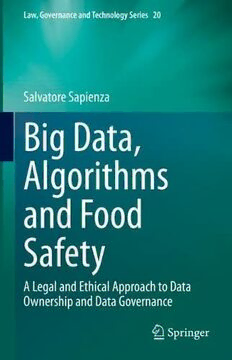
Big Data, Algorithms and Food Safety: A Legal and Ethical Approach to Data Ownership and Data Governance PDF
Preview Big Data, Algorithms and Food Safety: A Legal and Ethical Approach to Data Ownership and Data Governance
Law, Governance and Technology Series 52 Salvatore Sapienza Big Data, Algorithms and Food Safety A Legal and Ethical Approach to Data Ownership and Data Governance Law, Governance and Technology Series Volume 52 SeriesEditors PompeuCasanovas,UAB,InstituteofLawandTechnologyUAB,Barcelona, Spain GiovanniSartor,UniversityofBolognaandEuropeanUniversityInstituteof Florence,Florence,Italy The Law, Governance and Technology Series is intended to attract manuscripts arising from an interdisciplinary approach in law, artificial intelligence and infor- mation technologies. The idea is to bridge the gap between research in IT law and IT-applications for lawyers developing a unifying techno-legal perspective. The series will welcome proposals that have a fairly specific focus on problems or projects that will lead to innovative research charting the course for new interdisciplinary developments in law, legal theory, and law and society research as well as in computer technologies, artificial intelligence and cognitive sciences. In broad strokes, manuscripts for this series may be mainly located in the fields of the Internet law (data protection, intellectual property, Internet rights, etc.), Computationalmodelsofthelegalcontentsandlegalreasoning,LegalInformation Retrieval, Electronic Data Discovery, Collaborative Tools (e.g. Online Dispute Resolution platforms), Metadata and XML Technologies (for Semantic Web Ser- vices),TechnologiesinCourtroomsandJudicialOffices(E-Court),Technologiesfor Governmentsand Administrations (E-Government),Legal Multimedia, and Legal ElectronicInstitutions(Multi-AgentSystemsandArtificialSocieties). Salvatore Sapienza Big Data, Algorithms and Food Safety A Legal and Ethical Approach to Data Ownership and Data Governance SalvatoreSapienza Bologna,Italy ISSN2352-1902 ISSN2352-1910 (electronic) Law,GovernanceandTechnologySeries ISBN978-3-031-09366-1 ISBN978-3-031-09367-8 (eBook) https://doi.org/10.1007/978-3-031-09367-8 ©TheEditor(s)(ifapplicable)andTheAuthor(s),underexclusivelicensetoSpringerNatureSwitzerland AG2022 Thisworkissubjecttocopyright.AllrightsaresolelyandexclusivelylicensedbythePublisher,whether thewhole orpart ofthematerial isconcerned, specifically therights oftranslation, reprinting, reuse ofillustrations, recitation, broadcasting, reproductiononmicrofilmsorinanyotherphysicalway,and transmissionorinformationstorageandretrieval,electronicadaptation,computersoftware,orbysimilar ordissimilarmethodologynowknownorhereafterdeveloped. Theuseofgeneraldescriptivenames,registerednames,trademarks,servicemarks,etc.inthispublication doesnotimply,evenintheabsenceofaspecificstatement,thatsuchnamesareexemptfromtherelevant protectivelawsandregulationsandthereforefreeforgeneraluse. Thepublisher,theauthors,andtheeditorsaresafetoassumethattheadviceandinformationinthisbook arebelievedtobetrueandaccurateatthedateofpublication.Neitherthepublishernortheauthorsor theeditorsgiveawarranty,expressedorimplied,withrespecttothematerialcontainedhereinorforany errorsoromissionsthatmayhavebeenmade.Thepublisherremainsneutralwithregardtojurisdictional claimsinpublishedmapsandinstitutionalaffiliations. ThisSpringerimprintispublishedbytheregisteredcompanySpringerNatureSwitzerlandAG Theregisteredcompanyaddressis:Gewerbestrasse11,6330Cham,Switzerland 二千年後の君へ To You,in 2000Years Acknowledgements Humans cannot create anything out of nothingness. This book is no exception. It concludesajourneyandopensanewchapterinmyacademiclife.Icouldnothave done it without the support of many individuals within the academic community andoutside.Iamgreatlyindebtedtomyscientificsupervisorandmentor,Professor MonicaPalmirani,foradviceatthedifferentstagesofmyresearch.Sheofferedme her cross-disciplinary background to make me focus on the many “souls” of this book. TheLaw,Science&TechnologyLAST-JDboardprofessorsofferedmeprecious adviceduringmyPhD.Amongthem,ProfessorAntonVedderandProfessorMarc Cole (also PhD supervisor) provided useful comments in the drafting of the core parts of this book. Reviewers devoted time to read this book, and for that, I am thankfultothem,inparticularfortheirinsightfulcomments.MycolleaguesGiorgia Bincoletto,ChantalBomprezzi,FedericoGalli andValentinaLeonesupportedme with frequent exchange of opinions during our doctorate and sincere friendship also beyondwhat was requiredof them as co-workers(especiallyabroad).Noemi Conditi, Rachele Carli, Pietro Dunn and Paola Salomone, the newcomers in my PhD programme, made my doc-to-post-doc transition smooth and lovely. The last round of PhD students, Marco Billi, Gabriele Suffia, Malwina Wojcik and Yasaman Yousefi, are currently contributing to enhance my views with their new and fresh perspectives. Finally, not strictly related to the LAST-JD, yet linked to the CIRSFID—ALMA-AI research centre at the University of Bologna, I am thankful to Alessandra Foschi, Dino Girardi Jacopo Patrignagni, Vittoria Pistone and Michela Rossi for having provided the perfect working environment. My informatics colleagues—Leticia Decker de Sousa, Davide Liga and Francesco Sovrano—contributed to improve my knowledge on technical topics. Outside of theLAST-JDcircle,otherpeoplecontributedtoshapemyresearchpersonalitywith constructivesuggestions.ThegroupmadebyStefanoQuintarelli,FrancescoCorea, FabioFossaandAndreaLoreggiachallengedmymostmonolithicviewsbymeans oftheirheterogeneousexpertise. Finally, family and friends. Even though they can read English, my guess is that they would like to read some thoughts in our common language. Ringrazio vii viii Acknowledgements moltissimo i miei genitorie il resto della mia famiglia per il supporto ricevuto in questianni.Sesonoarrivatoaquestomiotraguardoèanchegrazieallaserenitàche hanno saputo garantire. Tra i miei preziosi amici ringrazio 353431541224344543 volteAndrea(X2),Sergio,Angelo,Gabriele,Giovanni,Giorgio(X2),Carlo,Ferdi, AgneseeChiara.InordinesparsoringrazioancheGiulia,Edoardo,Mattia,Alberto, Gianluca,Maddalena,Carlo,Vittorio,etuttelealtrepersonechehodimenticatoma chemeriterebberoapienotitolodiesserequi. Contents 1 Food,BigData,ArtificialIntelligence ..................................... 1 1.1 EmergingTrendsinFoodTechnology ................................ 1 1.1.1 BigData,theFoodIndustryandtheUNSustainable DevelopmentGoals ............................................ 3 1.1.2 SensorsandTraceabilityinAgriculture4.0 .................. 7 1.1.3 TheinsilicoAgeofFoodSafetyRiskAssessment: FromFoodTasterstoMachineLearning ..................... 9 1.2 HardTrade-OffsinDataOwnershipandDataGovernance: MappingtheDebate .................................................... 12 1.2.1 PropertyRights,ConfidentialityandTransparency .......... 15 1.2.2 InformationPrivacy,FoodConsumptionandData Transmissions .................................................. 16 1.2.3 BigDataandCompetitionintheFoodIndustry .............. 18 1.3 NovelTrendsinFood-RelatedDataProcessing ...................... 19 1.3.1 ’DataEthics’and‘SoftEthics’ ................................ 20 1.3.2 TheUntappedRelevanceofFoodConsumption Information ..................................................... 22 1.3.3 Big Data, AI, the Role of Principles in the ForthcomingRegulation ....................................... 23 1.4 ChapterSynopsis ....................................................... 25 References .................................................................... 25 2 DataOwnershipinFood-RelatedInformation........................... 33 2.1 TraditionalandEmergingApproachestoDataOwnership .......... 33 2.1.1 OwnershipModelsandData .................................. 34 2.1.2 ConfidentialityandDigitalCommons ........................ 38 2.1.3 Transparency,Truthfulness,Trust ............................. 40 2.2 RegulatoryandPolicyTrendsinOpennessandTransparency ....... 42 2.2.1 TheAarhusConventionandtheRighttoAccess EnvironmentalInformation .................................... 44 ix x Contents 2.2.2 TransparencyofFoodSafetyInformationintheEU Followingthe2021Reform(Reg.2019/1381) ............... 45 2.2.3 RecentCaseLawoftheEuropeanCourtofJustice: AShortCommentary .......................................... 59 2.3 A NewParadigmofData Ownershipin Food-Related Information ............................................................. 70 2.3.1 OpenQuestionsinFoodSafetyDataOwnership ............. 74 2.3.2 Towards a New Concept of Environmental Information ..................................................... 76 2.3.3 Trust-OrientedApproachestoDataOwnership .............. 78 2.3.4 DynamicOwnershipandSharedBenefits .................... 82 2.4 ChapterSynopsis ....................................................... 84 References .................................................................... 85 3 FoodConsumptionDataProtection ....................................... 89 3.1 FoodConsumption,SurveysandMobileApplications ............... 89 3.1.1 FoodSafetyDietaryIntakeSurveys ........................... 89 3.1.2 FoodDiaries,DataMash-Up,MixedDatasets ............... 93 3.1.3 FoodConsumptionData,DerivedandInferred Information ..................................................... 97 3.2 Dietary InformationProcessing and Data Protection BetweenLawandEthics ............................................... 98 3.2.1 Quasi-PersonalandQuasi-SensitiveData .................... 100 3.2.2 FoodConsumptionandLimitationsintheNotion ofPersonalData ................................................ 104 3.2.3 GroupPrivacyandDietaryPreferences ....................... 106 3.3 “YouAreWhatYouEat”:FoodandPersonalIdentity ............... 108 3.3.1 TheDataficationofFoodPreferences ........................ 111 3.3.2 FromFoodPreferencestoPersonalIdentity .................. 112 3.3.3 TheNextStepsinDietaryIntakeDataProtection ............ 116 3.4 ChapterSynopsis ....................................................... 118 References .................................................................... 119 4 CurrentTrends,MachineLearning,andFoodSafetyData Governance................................................................... 123 4.1 DataandAlgorithmicTransparency ................................... 123 4.1.1 TheShiftfromDeterministictoStochasticAnalysis ........ 124 4.1.2 PossibleBiasesinFoodConsumptionDataAnalysis ....... 127 4.1.3 OpeningtheBlackBox:TheKnowabilityApproach ........ 134 4.2 AccountabilityandRedressofProbabilisticModels ................. 137 4.2.1 FairnessinRiskAssessment ................................... 137 4.2.2 Responsibility,Accountability,Liability ...................... 141 4.2.3 MachineLearningandthePrecautionaryPrinciple .......... 145 4.3 TheEUDataGovernanceActanditsImpactonFoodData Governance ............................................................. 147
